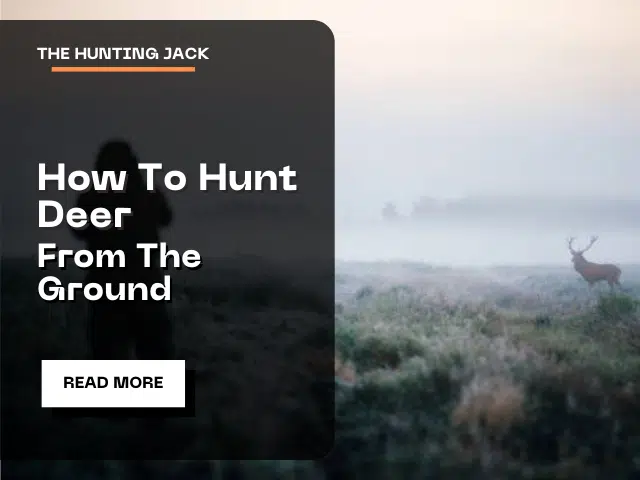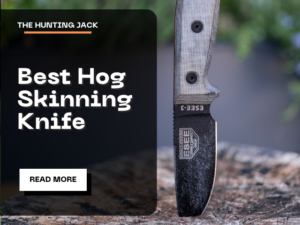Treestand hunters may disagree, but no adrenaline rush compares with hunting a whitetail deer from the ground. It’s almost a primal feeling when you go toe-to-toe with a mature buck on his level, just as hunters did millennia ago.
Elevated blinds and tree stands will always be more popular with most hunters. They make for easier and more convenient deer hunting, for one. Still, using woodsmanship, stealth and patience makes ground hunting a test your natural ability.
We’re hunting alert animals with a phenomenal sense of smell, hearing, and survival skills. Even with modern high-tech archery equipment, ground hunting is a challenge. Let’s look at some tips to narrow the playing field with your prey – you’ll likely need them.
Table of Contents
ToggleWatch and Check the Wind Direction
For a successful deer hunt, we all know the importance of keeping downwind of prey. It’s even more important to keep close tabs on the wind when taking on deer at eye level. When stand-hunting high in the trees, you’ll survive gusting and wind changes, but this is not the case on the ground.
Deer hunters hunting from the ground should check wind direction with floating detectors or powder. Floating detectors are, in my opinion, more reliable. They indicate wind shifts for a while after release, which is very helpful. Powder detection also works, but doesn’t remain visible as long as floaters as they vanish soon after being sent on their way.
Get yourself some lightweight floater detection for your hunting gear. You’ll be able to see wind shifts and swirling wind up to 50 yards from your location among the thick brush. This could make or break your ground-level hunting endeavors.
Exercise Outstanding Scent Control
Successful deer hunting relies on being scent-free. Great scent control is even more imperative if you’re hunting from the ground, so if you want to shoot any big bucks, don’t stink up the place!
Even if you’ve got a short hike to the cedar trees, you want to take necessary precautions to eliminate as much human odor and foreign scent as possible. Wash your body with unscented soap or body wash and your clothes in scent-free detergent. Use a scent-free deodorant. It would be best not to smoke or chew regular gum, even when hunting in a tree stand.
Dress light if you’re walking a distance, and wear knee-high rubber boots that will keep the smell of foot sweat inside. Use scent control sprays and even roll in the dirt and leaves if it’ll help. This may sound simple in theory, but it’s not necessarily the easiest thing to accomplish in practice.
The primary reason I mentioned your need to monitor and check the wind is that, as a human, you’re going to draw a deer’s attention with your scent. As much as we try, we’ll never be entirely scent-free. But we must try our very best, especially at ground level.
Blend in With Your Surroundings
At ground level, building a temporary blind using the available vegetation and any rocks or logs means you’re on your way to blending in. Ensure you’re well covered on all sides, including your front. Doing this will give you more freedom of movement without drawing unwanted attention to yourself.
Artificial “pop-up” blinds can also be beneficial. You’ll have to use as much natural cover to supplement a ground blind and make it stand out less to deer, even if its camo pattern is entirely suitable.
The great thing about temporary or pop-up ground blinds is that they conceal you from all sides. You’ll be able to carry out a full draw with a bow without much chance of detection. The same goes for aiming a crossbow or rifle.
Finally, do all you can do to ensure noise reduction. Clear your ground blind area of any leaves, twigs, weeds, and other remnants that may create sound if stepped on. Being calculating and silent can make the difference in pulling off an effective kill shot.
Assess what you’re wearing as well. Whitetails have incredible hearing. The slightest close-range sound (rustling clothes, for example) can spark a hasty retreat. Deer hunting is about precision, which goes for your movement and aim.
Set Up Your Location: Utilize the Terrain Properly
When you choose a location providing quality cover for hunting deer at ground level, assess the surrounding terrain. You’ll want to be able to keep the deer in your direct vision at all times, so the chance of being ambushed yourself is slim to none.
Whitetail deer hunting has a reputation for not sticking to the original screenplay. Mature bucks have a reputation for turning up unexpectedly – keep your “back to the wall” at all times. You want to stop the deer from having the upper hand in any hunting scenario.
Choose your natural barriers well. If you position yourself in ways incorporating the points of most resistance to big bucks, you’ll increase your shot options. Look for cliff faces, gullies, dense vegetation, fallen trees, and deep or fast-flowing water sections to use as barriers to prevent significant deer movement.
Yes, whitetail deer move through and over these obstacles daily and often take refuge in thick cover. I’m won’t deny that hardly anything in the woods will prove to be 100% resistant to mature bucks, but if they feel safe taking an easier route, they’ll do so. That’s why it’s essential to be appropriately covered in the front.
Another tip when selecting an area for your ground-level blind is to do a recon of the surrounding area. This way, you’ll recognize the most-traveled deer routes from droppings, tracks, and scrapes. This will also show you how regularly whitetails use the areas to behind and around your blind, helping you choose the best position.
Keep Your Movement to a Minimum
Moving about is second only to your scent as far as alerting deer when hunting from the ground goes. Unlike being in an elevated position, you’re directly in sight of your prey, and they are always watching for signs of danger.
Remain as devoid of motion as possible when doing ground deer hunting. You want to spot any deer before they spot you, and you don’t have eyes on the back of your head. Keep still.
The Correct Camo Counts
Leave your blue camo at home, especially when hunting from the ground. Whitetail deer pick up the color blue easier than any other color, so you don’t want to tip any off by wearing the wrong camouflage clothing.
Deep green, brown, and grey blend with the surroundings in the woods. Wearing camo in these colors increases your chance of a full draw and shot.
Another tip is to use a face mask, which isn’t necessary if you’re high up in a tree stand. A deer is more likely to see your face or hands at ground level, so wearing camo gloves is also an excellent idea.
Other Ground Hunting Tips to Consider
I’ve covered the most important tips for hunting from the ground, but others can help bag one of the big bucks in the area.
Choose your time
The early rut period sees big deer losing their heads as their male instincts and testosterone preoccupy them. During this time, mature male deer make more errors than at any other time of the year. They’re so busy concentrating on does reach estrus that many of their normal instincts and paranoia take a back seat.
If you’re planning a ground-level hunt, it makes sense to do so over this period when you might get away with being slightly less than perfect.
Carry minimal gear
You want to hunt deer, not have a tea party. Ground hunting needs you to be silent, stealthy, and invisible. The more you carry, the more chance you’ll draw attention to yourself. Take only the necessary gear, saving you energy if you’re on foot for miles on public or private lands.
Also consider how to carry your deer out of the woods – this is a considerable extra weight you’ll have to carry on the way home!
Extend your shooting distance
Hunting whitetails from an elevated position means you can easily take 20-yard shots or less, as you’re not as noticeable to the deer. When you’re on the ground, it’s not quite as easy. Don’t be Rambo and wait until your prey is right next to you, as you might regret it. If you plan for shots of between 25 and 40 yards, you’re more likely to have the opportunity to take one.
Take your bow stand along
Hunting deer from the ground is more difficult. You need to resist the urge to move more than necessary, and if your compound bow is always vertical and primed, you will move less. Take your bow stand with you for the hunt. If you don’t have one, seek a low-profile one that’s lightweight and foldable.
Shoot from a stool
Using a stool makes sense as a way of keeping as close to the ground as you can when you hunt deer. Deer will more likely spot you the higher up you are. As stools generally stand lower than chairs, this can increase your advantage. Being on a stool or the ground means you can still draw a bow or aim a rifle but from a lower and less conspicuous position.
Try using a crossbow
A crossbow can make hunting deer easier from the ground. Consider leaving your compound bow in the truck and, if permitted, use a horizontal bow as an effective alternative.
Create some decoys
It aids if a deer is distracted by something else when you’re drawing your bow. Using scent wafers where they’re allowed can distract a deer away from your position and line it up for a kill shot. You could also use model deer decoys, rubbing posts, or mock scrapes to draw your prey’s attention.
Stalk your prey
It’s worth a try if you see a deer in a prime spot to stalk. If you’ve brought slippers, slip them on or even wear your socks. Make sure the wind’s in your face and approach your prey slowly and stealthily. Why not? It’s tough enough hunting from the ground as it is, so why not take a chance when you have one?
FAQs
What is deer blowing?
Deer blowing is when a deer pushes out air through its nose, almost like sneezing. It does this when it notices potential danger from a distance. If you see this as a hunter, you’ve probably been spotted.
Will a deer come back to an area if spooked?
A deer that’s been spooked can return to a bedding area, but it won’t happen overnight. A lot depends on how spooked it was and whether it knew the threat. You might need to find another hunting spot if the deer detected your presence.
Does a deer have a sixth sense?
A deer hunter will undoubtedly acknowledge that a mature buck has a sixth sense. Whitetail deer seem to have an additional understanding on top of their keen sense of smell, incredible hearing, and excellent eyesight that alerts them to our presence.
In Closing
Is it clearer how to hunt deer from the ground now? Using tree stands when hunting whitetails is not always possible, so sometimes, staying firmly on Mother Earth is your only option. Even if it isn’t, you must admit there’s something special about being on the same level as your prey. Running that additional risk of being spotted is kind of exhilarating.
Going back to the hunting roots that we share with our ancestors is also something to savor. Sure, we’ve got plenty more to help us than they had. We can at least identify, in some way, with how good they had to be as hunters to reap the rewards of achieving their kill.



